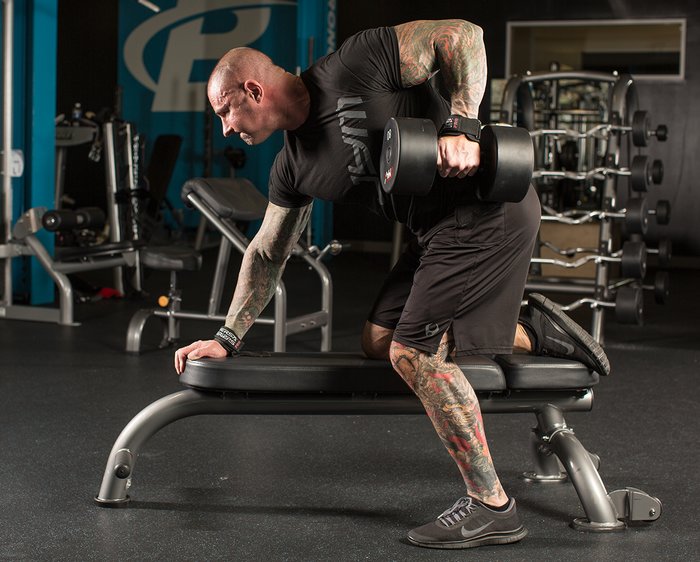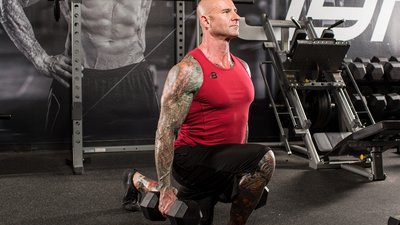Shocking a body part by "running the rack" is a great way to spur new muscle growth, and it's been around for decades. But there's more than one way to run a rack! I've got a new twist on this popular dumbbell training method, which I call my "5-System" for running the rack.
The "5" in the name signifies two things: 5 reps at a time, and running the rack up and back down in 5-pound dumbbell increments. Unlike the traditional way of running the rack, where you start with a heavy weight and rep your way down to a light one, here you'll do both—and you'll feel the difference.
Here's how it works, and my favorite moves to try it on.
The 5-System for Running the Rack
First, pick an exercise and select a weight that's relatively light for that move. For example, in my video I start with a 25-pound dumbbell for 5 reps of single-arm curls. For me, 25 pounds is light for a one-arm curl, but it's all relative. If 25 pounds feels fairly heavy, and "light" for you means a 10-pound or 15-pound dumbbell, then start there. You want to start light, just not so light that the first several sets are super easy.
With your starting weight, do 5 reps with each arm. Stopping at 5 reps will feel too easy at this light weight, but definitely stop there. Don't worry, it will get challenging very soon.
Without resting, go straight to the next, heavier dumbbell—30 pounds in my curl example—and repeat the sequence of 5 reps on each arm.
Continue running up the rack in this fashion, 5 reps per arm at each 5-pound dumbbell increment, until you can no longer do 5 reps per arm with good form. Feel free to do a couple cheat reps with the heaviest weight to reach 5 reps, but keep it to a minimum.

When 5 reps per arm is no longer happening, it's time to run the rack in the opposite direction. Let's say I wasn't able to get 5 reps with good form with the 55-pound dumbbell. I would set that weight down and go immediately to the 50-pounder for reps.
Now, on the way back down you may not reach 5 reps at every weight, especially on those first couple sets where the weight is still pretty heavy, because your muscles will be fatigued at this point. On these sets, just go to failure if you can't reach 5 reps, then switch arms and go to the next lighter dumbbell.
When you're back to your lightest weight, rep it out to failure. All those 5-rep sets will have your muscles screaming at this point, so that last set to failure with the lightest weight will be your burnout.
That's it. Up and down the rack once is enough, trust me!

How to Get the Most Out of the 5-System
The 5-System can be done for virtually any body part, and any dumbbell exercise: curls, one-arm rows, lateral raises, front raises, shrugs, overhead triceps extensions, just to name a handful.
I recommend doing one-arm versions of the exercise you choose so that the non-working arm gets a rest—albeit it a brief one—while the other is working. I'm not talking about alternating arms every other rep, as in alternating dumbbell curls. I mean using only one dumbbell at a time and doing all reps with one arm while the other arm gets a full rest without holding any weight.
I generally prefer using standing exercises with this method because it allows you to move quicker between sets without spending extra time getting up and down off a seat or bench. But you can certainly use seated exercises too, particularly if you want to train your chest using the 5-System method, since there's really no standing chest exercises you can do with a dumbbell.
Here are my favorite moves for each body part using this system:
Back
Biceps
Chest
- One-arm dumbbell press (flat bench or incline)
- One-arm dumbbell fly (flat bench or incline)
Legs
- Dumbbell step-up
- Dumbbell reverse lunge
- Dumbbell Bulgarian split squat (rear foot up on a bench or box)
- Single-leg squat
Shoulders
- Dumbbell lateral raise
- Dumbbell front raise
- Dumbbell bent-over rear-delt raise
- One-arm dumbbell overhead press
Traps
Triceps
Depending on your level of training, one time through the 5-System can either be incorporated into your routine as the last exercise for a muscle group, or even as your entire workout for the muscle group—especially if you're short on time.
Visit JimStoppani.com for more workouts, training tips, and articles on nutrition and supplementation.

